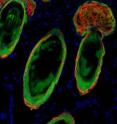Cells changing track: Thymus cells transform into skin cells in Swiss laboratory
Taking one type of cell and transforming it into another type is now possible. Cells taken from the thymus have been transformed into skin cells – a discovery that may have important ramifications for the field of organ regeneration. The findings, published on the 19th of August in Nature, show that these stem cells change their genetic make-up according to their environment to contribute to the long-term functioning of the skin, even producing hair for up to a year after implantation. In collaboration with the University of Edinburgh, UK, the Swiss research team with European colleagues* isolated thymic epithelial cells (TECs)-taken from the thymus of a rat-and integrated them into the rat's skin cells with surprising results. These epithelial cells taken from the thymus, an organ found in the thoracic cage, switch over from what they were originally created by the body to do and take up a novel role according to their new environment.
"These cells really change track, expressing different genes and becoming more important," explains Professor Yann Barrandon, head of the Laboratory Stem Cell Dynamics, a chair shared by the Ecole Polytechnique Fédérale de Lausanne (EPFL), the University of Lausanne and its teaching hospital (CHUV).
While in the thymus, these cells teach T-cells to recognize and destroy bacteria and cancer cells-a key component to the immune system. The experiment's results show that these cells have the ability to express genetic markers unlike its original make-up when placed in different microenviroments. Until now, experiments using hair follicle stem cells to maintain hair and skin growth have met with limited results. The thymic stem cells have proven effective for up to a year after implantation-a major improvement over the three-week performance of bona fide hair follicle stem cells.
"This operation could have theoretically been reproduced with other organs," continues EPFL Professor Barrandon. Not only could these findings create new opportunities in the field of organ transplantation and regeneration, for severe burn victims for example, but they also call into question standard biological models by showing that it is possible to create tissues from cells with different embryonic origins.
Source: Ecole Polytechnique Fédérale de Lausanne
Other sources
- Thymus cells transform into skin cells in Swiss laboratoryfrom Science DailyWed, 18 Aug 2010, 18:21:13 UTC
